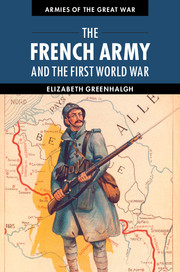Book contents
- Frontmatter
- Contents
- List of figures
- List of maps
- List of tables
- Preface
- List of abbreviations
- Introduction
- 1 The pre-war Army
- 2 1914: From the frontiers to Flanders
- 3 1915: On the offensive
- 4 1916: Verdun and the Somme
- 5 General Nivelle and his 1917 offensive
- 6 Restoring the Army
- 7 1918: German offensives
- 8 The path to victory
- 9 Armistices and demobilisation
- 10 From 1914 to 1919: Aux armes, citoyens!
- Notes
- Bibliographic essay
- Index
7 - 1918: German offensives
Published online by Cambridge University Press: 05 November 2014
- Frontmatter
- Contents
- List of figures
- List of maps
- List of tables
- Preface
- List of abbreviations
- Introduction
- 1 The pre-war Army
- 2 1914: From the frontiers to Flanders
- 3 1915: On the offensive
- 4 1916: Verdun and the Somme
- 5 General Nivelle and his 1917 offensive
- 6 Restoring the Army
- 7 1918: German offensives
- 8 The path to victory
- 9 Armistices and demobilisation
- 10 From 1914 to 1919: Aux armes, citoyens!
- Notes
- Bibliographic essay
- Index
Summary
The anticipated blow fell on 21 March when Ludendorff threw down his last card in his gamble to win the war before the British could transport, and the French train and equip, enough American troops in France to trump the numerical advantage that the Germans currently possessed. Following the armistice with Russia, forty-four German divisions had transferred to the Western Front. Although these now contained fewer men than an Allied division, some of them had been specially trained in the tactics that had won decisive victories at Riga and Caporetto. At least 188 German divisions faced 163 Allied infantry divisions in France: 58 British, 99 French, and 6 American. In addition the Allies had 12 Belgian divisions, the French and British divisions in Italy and the cavalry divisions. Of the 6 US divisions, however, 2 were still disembarking and none of the others was ready to fight. The French had armed the Americans: by 15 March the total supplied amounted to 156 batteries of 75s, 35 batteries of short 155s and 5 groups of the modern extra heavies, plus 2,894 machine guns and 12,864 automatic rifles.
Two offensives against the British front
The last intelligence before the Germans attacked reported 108 enemy divisions on the front, with 74 in reserve, whose whereabouts were known in about two-thirds of cases. The only enemy activity that the French had noted was two trench raids (coups de main) around Reims and Verdun; otherwise 20 March had been ‘a calm day overall’. Pétain believed that the German offensive was about to begin, as did General Cox, the new head of intelligence at GHQ. Pétain’s head of intelligence, Colonel Cointet, agreed with Cox on the two most likely areas of attack: the rivers Scarpe and Oise, and also in Champagne. They disagreed, however, on the relative weight of the attacks, Cox judging that the French sector would see the main action, because the political situation in France was less stable. Cointet believed, on the other hand, that the British would bear the brunt of the attack. Whichever assessment was correct, there was no joint planning to resist the enemy offensive. The only Franco-British arrangement concerned the use of reserves for support in case of emergency, and this had only been made because Haig and Pétain wished to avoid dealing with the SWC and supplying divisions for a general reserve.
- Type
- Chapter
- Information
- The French Army and the First World War , pp. 271 - 311Publisher: Cambridge University PressPrint publication year: 2014



